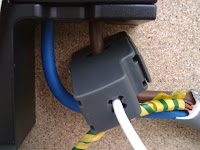Here is the result:
Conclusion
There is two phases in "leaving the immersion on" phenomenon:
- The initial heating of the water cylinder from cold to target temperature (set by the thermostat in the heater)
- Short bursts of about 5 minutes every hour or so to keep the water at target temperature
However if left on indefinitely and no hot water is consumed, the only additional energy required is to keep the cylinder at the target temperature. With modern well insulated cylinders it's not that much (relatively speaking). In my case a 5 minute burst of 6kW every 1.5 hours. That works out at about €1.20 / day or €8.40 / week assuming no hot water is consumed.
The blog post referred to above mentioned the ESB (power utility company) estimated the cost to be about €20 / week. Allowing for colder weather and reasonable hot water use that sounds about right. (I am assuming electricity costs €0.15/kWh unit.)
BTW: physics sanity check: my cylinder is 117 liters. Heating water from 20C to 80C ie ΔT of 60C. Requires 60 x 4.4kJ x 117 = 30888kJ. At 6kW that requires 30888/6 seconds = 5148 seconds = 1.43 hours. Which approximately squares with what I'm seeing above.






